Ccrn stuvia - Study guides, Class notes & Summaries
Looking for the best study guides, study notes and summaries about Ccrn stuvia? On this page you'll find 37 study documents about Ccrn stuvia.
All 37 results
Sort by
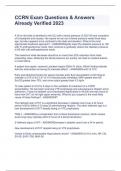
-
CCRN Exam Questions & Answers Already Verified 2023
- Exam (elaborations) • 16 pages • 2023
-
Available in package deal
-
- $10.59
- 2x sold
- + learn more
A 56 yr-old male is admitted to the ICU with a blood pressure of 225/135 and complains of a headache and nausea. He reports he ran out of blood pressure meds three days ago, but also appears to be confused to the date and situation. What is the most appropriate treatment approach? - ANSWERRapidly lower the diastolic pressure to 100 with IV antihypertensive meds, then continue to gradually reduce the diastolic pressure to 85 with oral antihypertensive meds. The maximum initial decrease should...
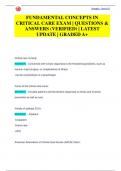
-
FUNDAMENTAL CONCEPTS IN CRITICAL CARE EXAM | QUESTIONS & ANSWERS (VERIFIED) | LATEST UPDATE | GRADED A+
- Exam (elaborations) • 18 pages • 2024
-
- $13.99
- + learn more
Critical care nursing: ANSWER: Concerned with human responses to life-threatening problems, such as trauma, major surgery, or complications of illness. -can be a physiologic or a psychologic Focus of the critical care nurse: ANSWER: Includes patient's and the family's responses to illness and involves prevention as well as cure. Variety of settings (ICU): ANSWER: -Inpatient -Outpatient -Home care -eICU American Association of Critical-Care Nurses (AACN) Vision: Deeagles - Stuvi...
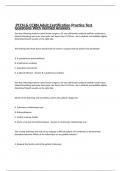
-
PCCN & CCRN Adult Certification Practice Test Questions With Verified Answers
- Exam (elaborations) • 17 pages • 2023
- Available in package deal
-
- $11.99
- + learn more
One day following posterior spinal fusion surgery a 35 year old female suddenly exhibits restlessness, labored breathing and acute chest pain. Her heart rate is 122/min., she is afebrile, and exhibits slightly diminished breath sounds on the right side. The findings described above should lead the nurse to suspect that the patient has developed: A. A spontaneous pneumothorax B. A pulmonary embolus C. Aspiration pneumonia D. A pleural effusion - Answer B. A pulmonary embolus One day f...
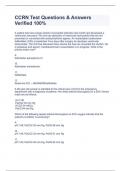
-
CCRN Test Questions & Answers Verified 100%
- Exam (elaborations) • 32 pages • 2023
-
Available in package deal
-
- $11.99
- + learn more
A patient has had a large anterior myocardial infarction last month and developed a ventricular aneurysm. He now has episodes of ventricular tachycardia that are not prevented or converted with antidysrhythmic agents. An implantable cardioverter-defibrillator (ICD) is implanted. Four days after surgery he develops ventricular tachycardia. The ICD has delivered three shocks but has not converted the rhythm. He is pulseless and apneic. Cardiopulmonary resuscitation is in progress. What is the prio...
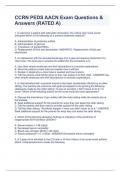
-
CCRN PEDS AACN Exam Questions & Answers (RATED A)
- Exam (elaborations) • 30 pages • 2023
-
- $12.49
- + learn more
1. In caring for a patient with salicylate intoxication, the critical care nurse would anticipate which of the following as a primary treatment measure? A. Administration of protamine sulfate B. Administration of glucose C. Transfusion of packed RBCs D. Replacement of fluid and electrolytes -ANSWER D. Replacement of fluid and electrolytes 2. An adolescent with the developmental age of a 4-year-old requires placement of a chest tube. The best way to prepare the patient for this procedure...
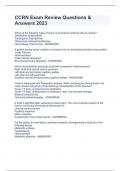
-
CCRN Exam Review Questions & Answers 2023
- Exam (elaborations) • 21 pages • 2023
-
Available in package deal
-
- $11.99
- + learn more
Which of the following types of shock is incorrectly matched with its causes? Distributive: Anaphylactic Cardiogenic: Dysrhythmia Obstructive: Adrenal Insufficiency Hemorrhage: Plasma loss - ANSWERSC A patient having which condition is at higher risk for developing infective endocarditis? Cystic Fibrosis Hydrocephalus Patent ductus arteriosus Bronchopulmonary dysplasia - ANSWERSC Which hemodynamic pressures would be increased in mitral stenosis? Right atrial and central venous pre...
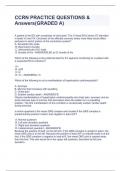
-
CCRN PRACTICE QUESTIONS & Answers(GRADED A)
- Exam (elaborations) • 19 pages • 2023
-
Available in package deal
-
- $11.99
- + learn more
A patient in the ED with complaints of chest pain. The 12-lead EKG shows ST elevation in leads V3 and V4. Occlusion of the affected coronary artery most likely would affect perfusion to which portion of the conduction system? A. Sinoatrial (SA) node B. Bachmann's bundle C. Atrioventricular (AV) node D. Bundle of His - ANSWERSLAD so D. bundle of his Which of the following is the preferred lead for ST segment monitoring for a patient with a suspected RCA occlusion? A.I B. aVR C....
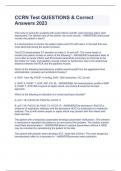
-
CCRN Test QUESTIONS & Correct Answers 2023
- Exam (elaborations) • 22 pages • 2023
-
Available in package deal
-
- $10.99
- + learn more
The nurse is caring for a patient with acute inferior wall MI, post-coronary artery stent deployment, For optimal care of the patient, the nurse should: - ANSWERSContinuously monitor the patient in lead II It is best practice to monitor the patient status post PCI with stent, in the lead that was most abnormal during the acute occlusion. The ECG demonstrates ST elevation in leads II, III and aVF. The nurse needs to monitor the patient closely for which of the following? - ANSWERSComplicati...
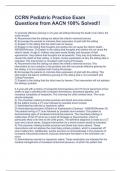
-
CCRN Pediatric Practice Exam Questions from AACN 100% Solved!!
- Exam (elaborations) • 24 pages • 2023
-
- $11.99
- + learn more
To promote effective grieving in a 6-year-old sibling following the death of an infant, the nurse should: A) Recommend that the sibling not attend the infant's memorial service B) Encourage the parents to minimize their expression of grief with the sibling C) Explain to the sibling that the infant went to heaven D) Explain to the sibling that thoughts and wishes did not cause the infant's death - ANSWERAnswer: D) Explain to the sibling that thoughts and wishes did not cause the infant's d...

-
Pediatric CCRN Questions & Answers (COMPLETE)
- Exam (elaborations) • 2 pages • 2023
-
- $7.99
- + learn more
SIADH lab values - ANSWERSerum Na <130, serum osm <280, BUN <10, urine osm >600, USG >1.030 DI lab values - ANSWERSerum osm >285, serum Na >145, urine osm <200, USG <1.010 Osmolality formula - ANSWER(Na x 2) + glucose/18 + BUN/2.8 Normal blood osmolality - ANSWER280

Study stress? For sellers on Stuvia, these are actually golden times. KA-CHING! Earn from your study resources too and start uploading now. Discover all about earning on Stuvia


